A Connectomic Atlas of the Human Cerebrum-Chapter 7: The Lateral Parietal Lobe
- PMID: 30260428
- PMCID: PMC6887702
- DOI: 10.1093/ons/opy261
A Connectomic Atlas of the Human Cerebrum-Chapter 7: The Lateral Parietal Lobe
Abstract
In this supplement, we build on work previously published under the Human Connectome Project. Specifically, we seek to show a comprehensive anatomic atlas of the human cerebrum demonstrating all 180 distinct regions comprising the cerebral cortex. The location, functional connectivity, and structural connectivity of these regions are outlined, and where possible a discussion is included of the functional significance of these areas. In part 7, we specifically address regions relevant to the lateral parietal lobe.
Figures



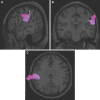

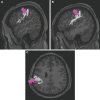





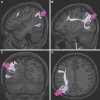
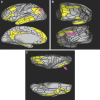

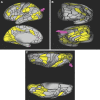


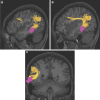

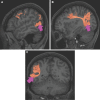

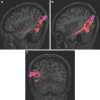


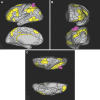
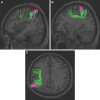




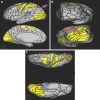
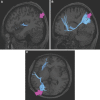
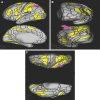



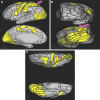




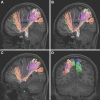

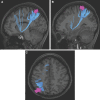



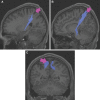





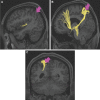
Similar articles
-
A Connectomic Atlas of the Human Cerebrum-Chapter 8: The Posterior Cingulate Cortex, Medial Parietal Lobe, and Parieto-Occipital Sulcus.Oper Neurosurg. 2018 Dec 1;15(suppl_1):S350-S371. doi: 10.1093/ons/opy262. Oper Neurosurg. 2018. PMID: 30260425 Free PMC article.
-
A Connectomic Atlas of the Human Cerebrum-Chapter 6: The Temporal Lobe.Oper Neurosurg. 2018 Dec 1;15(suppl_1):S245-S294. doi: 10.1093/ons/opy260. Oper Neurosurg. 2018. PMID: 30260447 Free PMC article.
-
A Connectomic Atlas of the Human Cerebrum-Chapter 9: The Occipital Lobe.Oper Neurosurg. 2018 Dec 1;15(suppl_1):S372-S406. doi: 10.1093/ons/opy263. Oper Neurosurg. 2018. PMID: 30260435 Free PMC article.
-
Microarchitecture and connectivity of the parietal lobe.Handb Clin Neurol. 2018;151:53-72. doi: 10.1016/B978-0-444-63622-5.00003-6. Handb Clin Neurol. 2018. PMID: 29519479 Review.
-
Exploration of the neural substrates of executive functioning by functional neuroimaging.Neuroscience. 2006 Apr 28;139(1):209-21. doi: 10.1016/j.neuroscience.2005.05.035. Epub 2005 Dec 1. Neuroscience. 2006. PMID: 16324796 Review.
Cited by
-
Temporal Electroencephalography Traits Dissociating Tactile Information and Cross-Modal Congruence Effects.Sensors (Basel). 2023 Dec 21;24(1):45. doi: 10.3390/s24010045. Sensors (Basel). 2023. PMID: 38202907 Free PMC article.
-
Spatiotemporal dynamics of cortical somatosensory network in typically developing children.Cereb Cortex. 2024 Jun 4;34(6):bhae230. doi: 10.1093/cercor/bhae230. Cereb Cortex. 2024. PMID: 38836408 Free PMC article.
-
Beyond eloquence and onto centrality: a new paradigm in planning supratentorial neurosurgery.J Neurooncol. 2020 Jan;146(2):229-238. doi: 10.1007/s11060-019-03327-4. Epub 2020 Jan 1. J Neurooncol. 2020. PMID: 31894519
-
Visuomotor processing is altered after peripheral nerve damage in neuralgic amyotrophy.Brain Commun. 2022 Feb 16;4(1):fcac034. doi: 10.1093/braincomms/fcac034. eCollection 2022. Brain Commun. 2022. PMID: 35233524 Free PMC article.
-
Cortical gyrification in children with attention deficit-hyperactivity disorder and prenatal alcohol exposure.Drug Alcohol Depend. 2021 Aug 1;225:108817. doi: 10.1016/j.drugalcdep.2021.108817. Epub 2021 Jun 18. Drug Alcohol Depend. 2021. PMID: 34171826 Free PMC article.
References
-
- Shalom DB, Poeppel D. Functional anatomic models of language: assembling the pieces. Neuroscientist. 2008;14(1):119-127. - PubMed
-
- Ishibashi R, Lambon Ralph MA, Saito S, Pobric G. Different roles of lateral anterior temporal lobe and inferior parietal lobule in coding function and manipulation tool knowledge: Evidence from an rTMS study. Neuropsychologia. 2011;49(5):1128-1135. - PubMed
Publication types
MeSH terms
Grants and funding
LinkOut - more resources
Full Text Sources
Other Literature Sources

